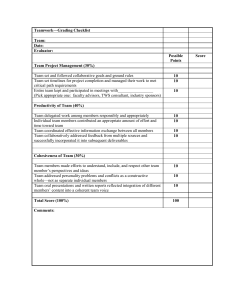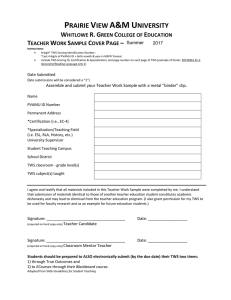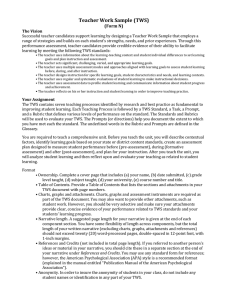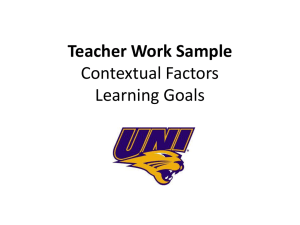2015-2016 Teacher Work Sample Template
advertisement
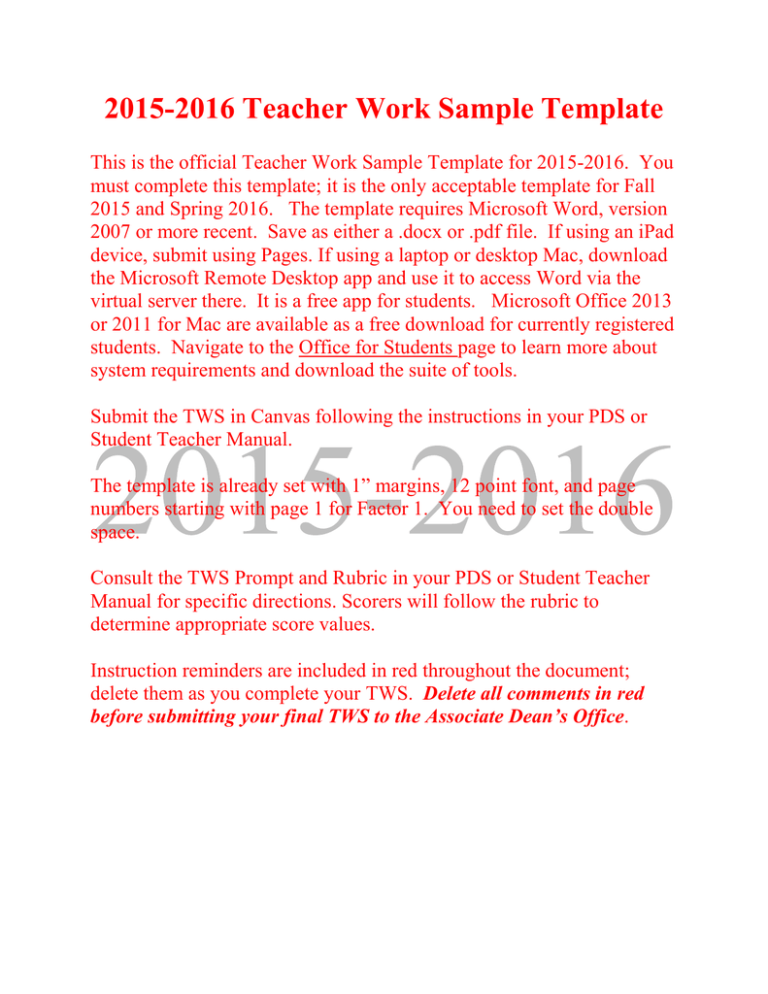
2015-2016 Teacher Work Sample Template This is the official Teacher Work Sample Template for 2015-2016. You must complete this template; it is the only acceptable template for Fall 2015 and Spring 2016. The template requires Microsoft Word, version 2007 or more recent. Save as either a .docx or .pdf file. If using an iPad device, submit using Pages. If using a laptop or desktop Mac, download the Microsoft Remote Desktop app and use it to access Word via the virtual server there. It is a free app for students. Microsoft Office 2013 or 2011 for Mac are available as a free download for currently registered students. Navigate to the Office for Students page to learn more about system requirements and download the suite of tools. Submit the TWS in Canvas following the instructions in your PDS or Student Teacher Manual. The template is already set with 1” margins, 12 point font, and page numbers starting with page 1 for Factor 1. You need to set the double space. Consult the TWS Prompt and Rubric in your PDS or Student Teacher Manual for specific directions. Scorers will follow the rubric to determine appropriate score values. Instruction reminders are included in red throughout the document; delete them as you complete your TWS. Delete all comments in red before submitting your final TWS to the Associate Dean’s Office. *Submitting the TWS Cover Page (Electronic submission through Canvas) Prior to submitting your TWS online through Canvas, you must submit a cover page using the link provided in the cover page module in Canvas. The cover page with electronic signature verifies that the TWS submitted is the candidates own authentic work. The candidates understand that obtaining, or attempting to obtain, a passing grade on a TWS by falsification or misrepresentation may result in a failing grade in a course or expulsion from the teacher education program. I understand that any misrepresentation of facts may result in the denial or revocation of my license. Teacher Verification Signature: Ask your cooperating/mentor teacher to send an email to Mary Benjamin (mbenjami@emporia.edu) stating: "This is verification that (insert student/intern’s name) submitting the TWS is a student teacher/intern at this school and that to the best of my knowledge it is his/her own work." This email must come from the cooperating/mentor teacher’s school email address. A Teacher Work Sample will not be scored without proper verifications from both the candidate and the cooperating/mentor teacher! You should NOT expect your supervising/ mentor teacher to verify your TWS without having an opportunity to review it. Candidates must submit/complete the Cover Page Module to access TWS submission. Remember: Completed TWS must be submitted on Canvas (see instructions on previous pages). TWS MUST be received NO LATER THAN 5:00 p.m. on the specified due date: Monday, November 16, 2015 for the Fall 2015 semester and Monday, April 18, 2016 for the Spring 2016 semester. Demographic Information Sheet (attach to your completed TWS after the Cover Page) Please indicate: Semester (Fall or Spring) Year: 20 Your certification/licensure level (check all that apply): _____ Early Childhood (Birth – K or Birth – Grade 3) _____ Secondary (Grades 6 - 12) _____ Elementary (Grades K - 6) _____ Dual (Elem. and Secondary, Grades PK - 12) _____ Middle School (Grades 5 - 8) Your certification/licensure area(s) (check all that apply): _____Art _____ Eng. Lang. Arts, Middle Level _____Physics _____Biology _____French _____Psychology _____Business _____German _____Science, Middle Level _____Chemistry _____History, Middle Level _____Spanish _____Early Childhd Uni B-8 _____History and Government _____Speech and Theatre _____Early Childhd Uni B-K _____Journalism _____Other:_______________ _____Earth-Space Science _____Mathematics _____Elementary _____Mathematics, Middle Level _____ English Language Arts _____Music _____ESOL _____Physical Education Identify the course, unit content are, (e.g., “English Language Arts,” “Biology,” “Mathematics,” “History and Government,” etc.), and grade level(s) of your Teacher Work Sample. Course Content Area The grade(s)/level of students in your classroom (check all that apply): _____Preschool _____4th Grade _____9th Grade _____Kindergarten _____5th Grade _____10th Grade _____1st Grade _____6th Grade _____11th Grade _____2nd Grade _____7th Grade _____12th Grade _____3rd Grade _____8th Grade Factor 1. Contextual Information and Learning Environment Adaptations 12 point font, 1” margins, and page numbers are set. You need to set the double space for all of your narrative. Use the headings given in the template. Provide background information for what you will put in the table and give specific numbers. A thoroughly prepared contextual table will reduce the amount, or completely eliminate, the need for additional narrative, but narrative must be used if it is needed to provide sufficient information to address the rubric items. A blank contextual factor table is included below and a sample is included in the TWS Prompt and Rubric. If there is no implication for instruction for a contextual or environmental factor, be sure to explain why. The page count starts with the first page of Factor 1 and cannot exceed 25 pages. A) Explanation of community factors that impact my planning and teaching B) Explanation of these factors that impact my planning and teaching 1. District 2. Classroom physical setting 3. School population, including socio-economic status (SES) make-up C) Explanation of these factors that impact my planning and teaching 1. Classroom’s ethnic/cultural make-up 2. Classroom’s gender make-up 3. Classroom students’ with special needs/at-risk students 4. Classroom students’ developmental characteristics D) School Improvement Plan and state assessment data. E) Explanation of community, district, school, classroom, and student factors and implication for instruction. Be sure to address all factors that have implications for your instruction. Optional Contextual Factor Table (add rows as needed) Contextual and Environmental Factors Identify Source of Factor: Community, District, School, Classroom, or Student Implications for Instruction 1 Factor 2. Unit Learning Goals and Objectives Use the headings given in the template. A) Course, unit content area, and grade level of the Teacher Work Sample: B) Rationale for choice of unit objectives: C) Standards that the outcomes are aligned with: Include enough narrative here to show the relationship between what you are teaching and the standards. Use State Standards or Common Core Standards unless none exist for your subject area. If no State Standards exist, use Local or National Standards. 2 D) Unit learning goal and outcomes for this instructional sequence. You need at least 1 goal and two objectives for each level. Add rows to table as needed. List all your low level objectives, then all your middle level objectives, then all your high-level objectives. Goal(s): Indicate TWS objectives with * Objective # (use to code your objectives) Stated Objective Level of objective Domain of objective (cognitive, (Low, middle, or high) affective, or psychomotor) 3 Factor 3. Instructional Design and Implementation Include as Attachment #1 a copy of your pre-assessment and post assessment items/activities. This can be a copy of the assessment with the correct answers provided. The pre/post assessment must measure all TWS objectives identified in Factor 2. Attachments do not count as part of your 25 pages. A) Design for Instruction Table (add rows as needed) Timeline Learning Objectives (use your coding from Factor 2 to save space) Instructional Activities, including interdisciplinary activities Resources Assessments and Technology Teaching and Reading adaptations for specific students and subgroups* based on identified contextual and/or pre-assessment needs Day 1 Day 2 etc. * Subgroups should be no smaller than 10% of the total class. B) Narrative 1) Explanation of how the instructional plan addresses multiple types/levels of learning throughout the unit 2) Explanation of how adaptations effectively address the specifically identified contextual needs of the individuals, small group, or class. 3) Justification of how the unit actively engages students in questioning concepts, developing learning strategies, seeking resources and conducting independent investigations. 4) Explanation of implementation of instructional strategies for student use of reading materials related to the subject. Explanation of how these strategies incorporate techniques that allow for assisting with a wide range of reading concerns and abilities. 5) Explanation of how technology makes a meaningful contribution to learning or a rationale is given why it is inappropriate to use technology with students in this particular lesson. 4 6) Explanation of how instructional design and implementation demonstrates knowledge of specific factors in the students’ environment outside of school; how this knowledge is included in the plan for instruction. Factor 4. Demonstration of Integration Skills A) Content areas being integrated (example: history, literature, music, etc.): B) Topics within the subject being integrated (example: the civil war): C) Explanation of how the instruction plan created learning experiences in which students integrate knowledge, skill, and methods of inquiry from other subject areas, and within a subject area. Reference specific days and activities from the Design for Instruction Table and specific assessments from the Assessment Plan Table. From other subject areas: Within my subject area: Factor 5. Analysis of Classroom Learning Environment Continue to use the headings given in the template. Except for your classroom management plan, your comments should be related to the specific unit. (Checklist items) A) Description of classroom environmental factors that affect learning B) Description of individual student motivation strategies used 5 C) Description of group motivation strategies used D) Description of how verbal communication among students was developed E) Description of how nonverbal communication among students was developed (Rubric items) F) Description of at least three classroom management strategies that will provide evidence of a sufficient and comprehensive classroom management plan. G) Description of motivational techniques used and how they are applied in the unit. H) Evidence of effective student-to-student communication specific to the learning I) Description of examples of inquiry learning that show an environment that involves students in inquiry learning activities J) Description of how students are actively involved in most learning activities and in cooperative or group work. Factor 6. Analysis of Assessment Procedures Include as Attachment #1 a copy of your pre-assessment and post-assessment items/activities. This can be a copy of the assessment with the correct answers provided. The pre/post assessment must measure all TWS objectives identified in Factor 2. The attachments do not count as part of your 25 pages. A) Graphic representation of pre-assessment and post-assessment data. Disaggregated data for at least one pair of subgroups. Subgroups should be no smaller than 10% of the total class. Note that a table is not a graphic representation. 6 B) Assessment Plan Table (add rows to the table as necessary) Assessments 1. Preassessment 2. Formative Assessment 3. Formative Assessment 4. Formative Assessment (etc.) 5. Postassessment TWS Objectives (Use TWS Objectives identified in Factor 2.) Type of Assessment (Include a brief description and criteria for mastery.) Adaptations All TWS Objectives . All TWS Objectives Same as pre-assessment. C) Mastery Learning Table (add rows to the table as necessary; the cells with X’s do not require data.) TWS Objectives Percentage of Students Achieving Mastery on each TWS Objective Average Number of Percentage Students of Students Who Achieving Achieved Mastery for Mastery each Level with of Objective Adaptations Low level objectives: XXXXX Low Level Mastery Objective Index Sub-categories score. (Average of percent of students achieving mastery of low level objectives.) XXXXX XXXXX Middle level objectives: XXXXX Middle Level Mastery Objective Index Sub-categories Score. (Average of percent of students achieving mastery of middle level XXXXX XXXXX objectives.) High level objectives: 7 High Level Mastery Objective Index Sub-categories Score. (Average of percent of students achieving mastery of high level objectives.) Objective Mastery Index (Average of percentage of students achieving mastery using all TWS Objectives.) XXXXX XXXXX XXXXX D) Table of learning gain scores and overall average gain. Include a table showing pre- and postassessment scores for each student, calculated gain score for each student, and the group average gain score. E) Describe subgroup performances on low, middle, and high level TWS Objectives. Provide the number in each subgroup. TWS Objectives Subgroup 1: (# in group) Subgroup 2: (# in group) Low Middle High If subgroup performances are different, explain why you think they are different or similar. F) Explanation of how student progress was monitored by pre-assessment data and used appropriately in instruction and decision-making. G) Explanation of how student progress is monitored by assessment data and used in instructional decision-making. Provide examples to illustrate. H) Explanation of how student progress is monitored by appropriate post-assessment data and is used appropriately in instructional decision-making or planning. 8 I) Explanation why you have chosen each assessment you used to measure your TWS Objectives. J) Justify your assessment adaptations Factor 7. Reflection and Self-Evaluation (Have you deleted all of the text in red? How close to 25 pages are you now?) A) Successful activities and assessments and plausible reasons for their success. Unsuccessful activities and assessments and plausible reasons for their lack of success. B) Explanation of use of evidence and data to support conclusions that student learning was impacted, including description of any mid-unit adaptations. Explanation of two or more hypotheses for why some students did not meet subject matter goals. C) Three appropriate ideas for redesigning learning goals, instruction, or assessment and explanation of why these changes would improve student learning. D) Explanation of specific details of interactions with all three types of individuals: students, parents and other professionals. E) Explanation of the school improvement process and the role of the teacher in it. F ) Explanation of two professional development goals that clearly emerge from the insights and experiences described in this Factor and description of one activity to meet each goal. 9

